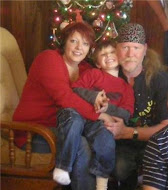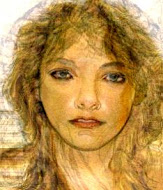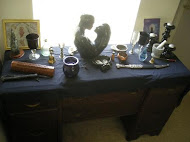Yule
This post is taken in entirety from
The Element Encyclopedia of Witchcraft
by Judika Illes
The ancient Germanic calendar was divided into six periods of 60 days each, known as tides. Each tide was the equivalent of two modern months. Yuletide refers to the two-month tide corresponding to modern December and January. The winter solstice falls within this period, as does the 12-day period commemorated as the Twelve Days of Christmas. Similar to Halloween or the February Feasts of Purification, the veil between realms is thin during this time and ghosts and spirits walk the land.
Yule may be defined in either of several ways:
- as the Nordic pagan festival that once began at the W inter Solstice
- as an alternative name for Christmas; those who use that name tend to emphasize pagan survivals within Christmas, however not necessarily to the exclusion of Christian elements. This Yule begins on the evening of December 24th, regardless of the specific timing of the Solstice.
- as the modern Wiccan sabbat that corresponds to the Winter Solstice.
The word "Yule" may derive from the name of a Nordic festival. Juleiss was the name of the Gothic month of celebration and fun. In Dutch, "joelen" means loud, fun, raucous partying. (My Dutch source suggests that joelen is what a crowd does during a football match!) Yule may also derive from the Anglo-Saxon word for "wheel," commemorating the cutting and rolling of the Yule log.
Christmas is permeated with Pagan traditions. The period of time beginning with the Winter Solstice, and continuing for at least the next twelve days was a popular time for festivals in the pre-Christian world. Many traditions and rituals have since been absorbed into the Christian celebrations.
These December festivals included:
The Nordic festival of Yule. Its elements included the yule log, the yule boar, and devotion to evergreen trees. Odin, the shaman god, sometimes resembles the jolly gift-giver alternately known as Santa Claus, Father Christmas or Old Saint Nick. Odin studied shamanism with the neighboring Saams and perhaps learned something about herding reindeer, too. Although Odin isn't the elven king - that's Freyer's job - the elves and Odin do come from the same territory.
- The Saturnalia and the Feast of Ops: the Roman festival in honor of Father Time, also known as Saturn , and his consort Ops. For the Romans, Saturn was king of an ancient "golden age" of perfect happiness, before people had to farm for a living. His festival looks back to that early age with nostalgia. The Saturnalia celebrated the solstice and sought to protect winter-sown crops, but above all the Saturnalia was a joyous, merry festival characterized by gift-giving, especially to children. The Saturnalia counts among the wild, anarchic festivals. There are rituals to encourage fertility. Gambling and gaming was encouraged; cross-dressing was popular. Social distinctions were reversed, so for a few days a slave could be master. The ancient deity Saturn also bears something of a resemblance to that white-bearded ode gentleman, Good Saint Nick.
- The Rural or Lesser Dionysia: allegedly the most ancient of the Greek festivals honoring Dionysus. Held at the very beginning of January, on this day even slaves enjoyed freedom. A procession was held which included a goat bearing a basket filled with raisins. An erect wooden pole carved to resemble a phallus and decorated with ivy was carried in the procession, too.
- The Mother's Night: a Germanic midwinter festival associated with the Norse deity Odin. According to the monk, historian and scholar the Venerable Bede (c. 672 - May 25, 735 CE) the Mothers' Night corresponded in time with Christmas Eve and was the most important pagan festival in eighth-century Britain. Little information about the holiday survives. Mothers were apparently honored as were perhaps the ancient European deities known as the Matronae or "The Mothers." Divination was practiced at this time. Dreams on this night were believed to reveal the future.
In Russia, The season coinciding with Christmas was a time traditionally celebrated with cross-dressing, dressing as animals, masking and mumming.
December is the time for dancing, singing, and feasting, a time when men masquerade as animals and especially as the Horned God. The Horned One carries a small broom of birch twigs with which to generate and enhance fertility power. His face is blackened with soot or charcoal dust so that he looks as if he's come down the chimney. (It's meant to emphasize his fertility and immortality, similar to the way ancient Egyptians painted Osiris black when the wished to emphasize his resurrection from the dead and the immortal life he had achieved.)
These wild defiant celebrations found their place within the Christmas. To this day conservative evangelical Christians discourage pagan elements within the holiday, suggesting that followers "put the Christ back into Christmas." Until fairly recently, Christmas, and particularly these pagan elements, was considered somewhat disreputable. It was once considered a wild and raucous holiday, which the defiant, anarchist forces of Earth attempted to dominate.
The New England Puritans refused to celebrate Christmas, for instance, while, in 1801, the Pennsylvania House of Representatives forbade masquerading at Yule. The punishment was to be no more than three months imprisonment and a fine between $50 and $1000, which was an incredibly large sum of money in those days. And in 1881, Philadelphia law banned Christmas Eve masquerading. (Not a problem; revelers simply mover their festivities to New Year's Eve. Many customs now associated with New Year's Eve were once identified with Christmas.)
Why? What were people doing?
Celebrations of the Horned One, excised from May Day, Midsummer's and especially Halloween, survive at Christmas time. This is particularly apparent in the parts of Europe where Father Christmas has an official helper, like Black Pete or Krampus, Santa Claus himself may be the Horned One, albeit now in a padded suit. (See HORNED ONE.: Krampus) German immigrants to the United States formed a sizable community in the state of Pennsylvania. They brought their raucous Yule traditions with them.......
To be continued when moving is done - puter is coming down















No comments:
Post a Comment